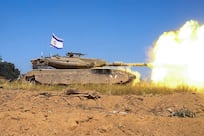The American Civil War general William Tecumseh Sherman spoke from experience when he referred to war as “hell”. It is an observation that has lost nothing of its meaning in the intervening years, especially in our own conflict-ridden world.
The fabled photographer Don McCullin regularly caught the “hell” of war in the eyes and faces of his subjects. His image of a shell-shocked US soldier in Vietnam is a photograph that, once seen, can never be forgotten.
For me, however, the most haunting of all McCullin’s photographs is his 1969 shot of a nine-year-old boy clutching an empty tin of corned beef in war-torn Biafra, Nigeria.
It is an image that also continues to torment the photographer decades on: “He was an albino boy and he was standing looking at me, barely managing to stand on his spindly legs ... he was making me feel so ashamed,” recalled the photographer in the 2012 documentary film McCullin.
It remains a pertinent reminder of how war impacts on the most vulnerable and impressionable members of our society: our children.
The Middle East has rarely been spared the torment of war. It is hard to imagine a more chaotic, more violent, more complicated state of affairs than the one the region finds itself in at the present time.
As the bitter stand-off between Israel and Palestine continues unabated, Iraq finds bloodier ways to wreak havoc on its war-weary citizens, Egypt teeters to and from the brink, Libya effectively assumes the guise of failed state and Syria devours itself in a civil war that threatens to take Lebanon with it and create a lost generation of children in an already fragile region.
During the dark days of Lebanon’s 15-year civil war (1975-1990), a whole country was plunged into conflict. At its end, around 150,000 people had been killed and countless others wounded.
A 1988 study on the impact of the Lebanese civil war on the country’s children showed that 90 per cent of a sample of youngsters had been exposed to shelling or combat, 68 per cent had been displaced from their homes, 54 per cent had experienced extreme poverty, 26 per cent had lost someone close to them and just over 20 per cent had been separated from their families. A further study sample also revealed that nearly three per cent had actively participated in the fighting itself.
Three years into the bitter and bloody civil war in Syria and the statistics reveal something altogether more frightening.
In a crisis that the United Nations Children’s Fund (Unicef) has described as the “most damaging conflict for children in the region’s recent history,” the number of Syrian children in need of assistance because of the war has run into the millions, the number killed, many due to deliberate targeting, in excess of 10,000.
Speaking earlier this year, Simon Ingram, Unicef’s Middle East and North Africa regional chief of communications, described how Syria’s internally and externally displaced children were suffering from great psychological distress.
“Here we are talking about the hidden injuries, the hidden wounds that have been inflicted on children because of what they have experienced; the behavioural changes, the nightmares that they carry around with them – the way in which they can no longer function as normal children do. And, this is an aspect of the crisis, which has been too often overlooked, but which is growing all the time,” he explained on a Voice of America broadcast.
The emotional impact of war on children was recently explored in an exhibition in the US called A Child’s View From Gaza, which showcased the artwork of those Gazan children caught up in Operation Cast Lead – the Israeli offensive against Gaza in 2008 and 2009.
The exhibition, featuring drawings by those youngsters who participated in after-school children’s therapy sessions, may have faced opposition from some Jewish groups who classed it as propaganda, but it provided an unvarnished insight into a world where one’s childhood is a perennial war zone.
As Syria, Iraq and Gaza struggle to regain control of their societies, what of the children who grow up with the noise of gunfire, car bombs and armed helicopters swooping overhead ringing in their ears?
What of the children who see their communities devastated, their friends and family killed, their own lives subjected to daily hardship, the likes of which most of us can only imagine?
For Arab children caught up in war zones, the vicious cycle of violence and hatred that passes for routine is surely hard to compartmentalise, and it is no revelation that such turmoil leads many of the youngsters themselves to turn to violence, condemning the story to continue without end.
As the war in Syria tears through the heart of every community in the country – touching every life and tormenting every family – is it possible to imagine another 12 years of conflict, as was the case in the historical precedent provided by Lebanon’s devastating war?
It is hard to imagine anything but a lost generation of children, spanning multiple countries, is all but a certainty.
And, what is worse is the feeling that there is nothing any of us can do about it.
Alasdair Soussi is a freelance journalist, covering the Middle East and Scottish politics
On Twitter: @AlasdairSoussi




